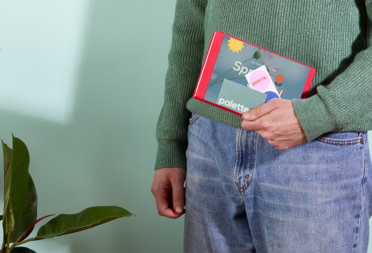A milestone on MOO’s sustainability journey
Meet Luke, MOO’s new Head of Sustainability.

One of our core values here at MOO is “Make it sustainable.” That means we approach every decision we make about everything from our products to our drinks in the office with a focus on sustainability.
A key event on our journey towards a completely sustainable future happened this summer at MOO: we hired our first ever Head of Sustainability, Luke Landers. Read on to learn more about his first few months at MOO, the companies we work with, and what it takes to create an impactful sustainability strategy.

What surprised you most about MOO when you first joined?
I’ve been most surprised by the level of interest in sustainability from across the business. As you’d expect, I spent lots of time in my early weeks meeting the team. Introductory chats are usually that – you barely get a chance to scratch the surface of sustainability and it’s easy to get bogged down in why your role exists. At MOO, I’ve found myself swept up by the desire to take action. Deep conversations have ensued, meetings have overran, cups of tea have gone cold, but it’s refreshing to be met with that palpable positivity and desire to progress sustainability.
Can you tell me a bit about our suppliers and why we work with them?
MOO works with some of the world’s leading suppliers of paper and custom products. Each has been carefully selected not only for their quality, but also their alignment to MOO’s MAKEIT values.
Of MOO’s values, I’m particularly interested in the M of the MAKE it acronym – this stands for “Make it sustainable.”
This value highlights our ambition to work alongside partners who are just as mindful of people and planet as we are. So whether that’s careful sourcing, low-impact manufacturing, or treating people right, you can be confident we’re collaborating with partners who share the same high standards.
In my first couple of weeks I was fortunate enough to visit Holmen, a partner who supplies around 70% of our paper. Visiting a paper mill I expected to see an industrial process. However, I was really encouraged to see a “softer” side. There was a contagious passion and care for the forest, and it was incredible to see this level of environmental stewardship throughout the process. Following Sweden’s Forestry Act, Holmen carefully manage the entire lifecycle of the forest – starting with the thoughtful selection of seedlings that will flourish, balancing cultural considerations like reindeer herding, nurturing the trees throughout their 70 to 90-year lifespan, and ultimately harvesting only the most suitable trees.

Why do you consider sustainability a journey rather than a destination?
Sustainability is a continuous process, constantly adapting to minimize the negative and maximize the positive. With a backdrop of changing conditions and a mindfulness of future generations, there’s a need for ongoing action.
It can feel like a strange concept, or a gray area, but it doesn’t mean there aren’t milestones along the way that are important or can’t be celebrated.
What makes a good sustainability strategy?
There’s a few key elements:
Authenticity – You can’t just pull a strategy off the shelf. It has to fit your business, your culture. Yes there’ll be shared aspirations with other organizations but how you tackle challenges will be unique to you.
Clear vision and ambition – How far are you genuinely looking to drive change? If you’re not disrupting BAU then it’s not enough. Likewise, a good strategy will outline how fast you plan to get there.
Data-driven – Data will help determine where the most significant impacts and opportunities are. This will focus the strategy in the right areas. Plus, it’ll help you see how far you’ve come.
Transparency – Your strategy should be something you’re not scared to share with customers, employees, suppliers, or other businesses. Their buy-in can help make it a reality and might empower others to act.
What would you like to see change at MOO over the next five years?
I’m looking forward to seeing how MOO can develop its regenerative focus. This means, not only aiming to do no harm, it’s focused on delivering benefits or reversing harm. This could take many shapes but might incorporate initiatives like exploring alternative materials, energy efficiency and generation, eliminating waste, promoting community well-being, or developing supply chain sustainability. I’m passionate about this as it has the potential to bring about positive change across a breadth of areas.

What is something in the world of sustainable merch we already do really well?
Embedding sustainability into the design of our products. There’s incredible attention to detail to not only deliver delight but to try and align to the principles of circularity (use less, use longer, use it more, use it again). There are many decisions that have to be made, options discounted and alternatives refined to try to balance functionality, aesthetics and sustainability.
Take our Twist Pen – it’s beautiful to write with and it’s something you can hold with pride. The real winner for me though, is the fact that it’s designed to be enjoyed for a while. Not only is it made from aluminium, which means it’ll stand up to whatever gets thrown at it when scribbling down notes, it’s refillable. Then, when it eventually does come to the end of its useful life, the pen is recyclable (keeping those precious materials in circulation ready to live another life).
When it comes to sustainability, it’s all about doing what you can
It’s often the smaller things that have the biggest impact, like giving staff their own refillable Water Bottle, or switching to a recyclable Eco paper.
Wherever you are on your sustainable print and merch journey, we’d love to help you along. Fill in our form below and we’ll be in touch.
Keep in touch
Get design inspiration, business tips and special offers straight to your inbox with our MOOsletter, out every two weeks.



